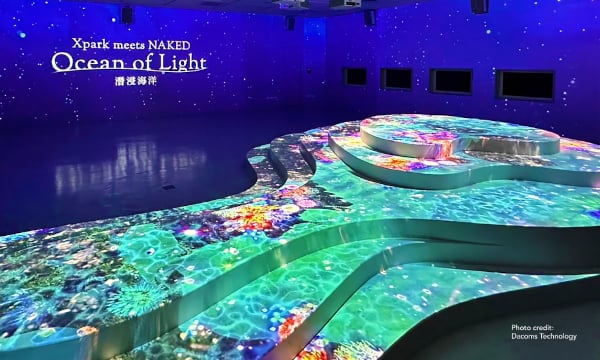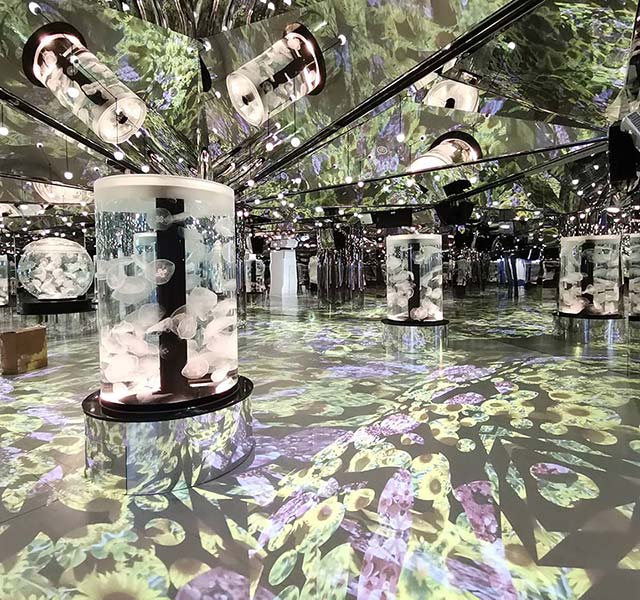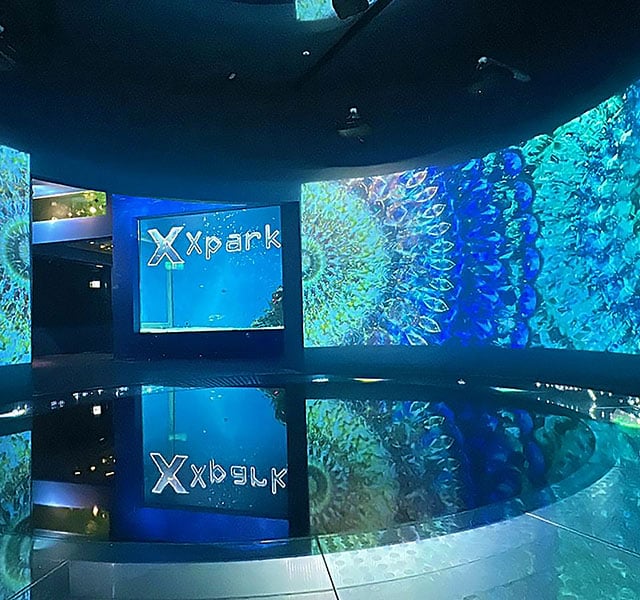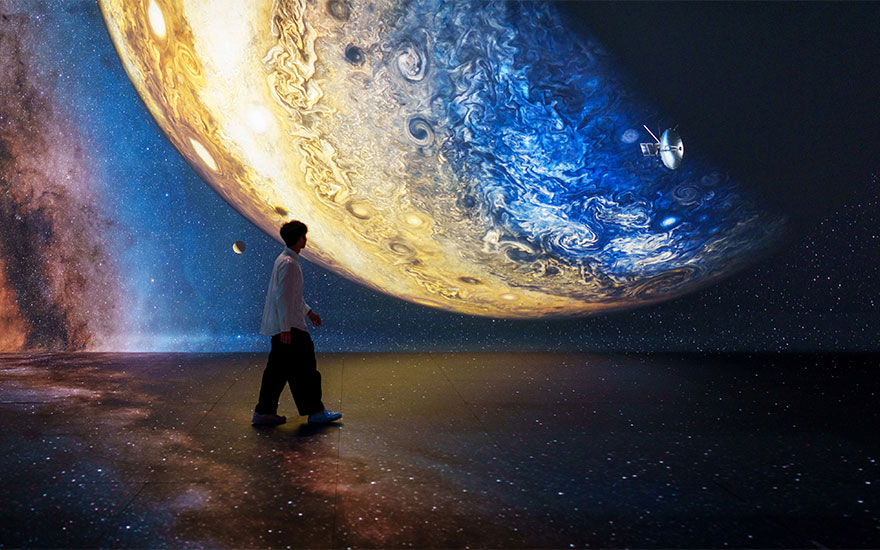A Q&A with Dacoms’ Terence Lee
Since its opening in 2020, Xpark Aquarium in Taoyuan, Taiwan, has become a benchmark for immersive edutainment, blending living marine habitats with digital storytelling. At the heart of this transformation is Dacoms Technology, a long-time Christie partner and one of Taiwan’s leading ProAV systems integrators. From the original 2020 installation to the recent “Ocean of Light” expansion, Dacoms has worked hand-in-hand with Xpark to push the boundaries of what projection can achieve in a dynamic, operational aquarium.
In this exclusive interview, Dacoms Executive Vice President Terence Lee reflects on five years of innovation, collaboration, and technical mastery that continue to redefine audience engagement in Taiwan and beyond.
Dacoms’ Role and Partnership with Xpark
Q: Dacoms has been involved with Xpark since its opening in 2020. How did this partnership begin, and what was your initial vision for the aquarium’s projection and AV systems?
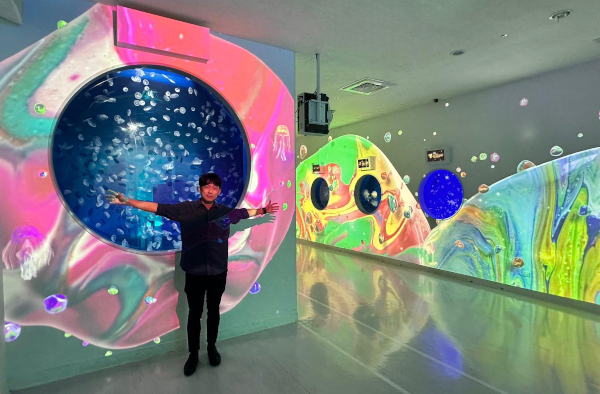
Terence at an "Ocean of Light" exhibit displaying marine life alongside projected images.
Photo courtesy of Dacoms Technology
Terence Lee (TL): Ever since I learned that the renowned Hakkeijima Sea Paradise in Japan was planning to establish its first overseas branch in Taiwan—what would later become Xpark Aquarium—I visited them to present a proposal and showcase Dacoms’ strengths and service capabilities. At the time, Taiwan lacked a venue offering a fully immersive experience, and I hoped this project would introduce an unprecedented fusion of virtual and real-world elements to inspire Taiwanese children and the general public.
Q: How has Dacoms’ relationship with Xpark evolved over these five years, especially in terms of your role as a projection designer and systems integrator?
TL: We’ve become increasingly in sync. Service is always our top priority. Since Xpark operates 365 days a year, I’m especially grateful to our service team members, who consistently respond quickly and resolve issues efficiently. This has allowed Xpark to experience not only our technical expertise, but also our sincere commitment to customer service and attentiveness to their needs.
Technical Execution and Challenges
Q: The original installation at XPark in 2020 was described as one of the most complex and demanding projects Dacoms had undertaken. What were some of the key challenges, and how did your team overcome them?
TL: Time was the biggest challenge. We had only about six months from proposal to completion. We had to deliver 13 exhibition areas using 71 projectors, including projections on curved surfaces. Taiwan’s humid climate and the proximity to seawater tanks also posed major challenges to the equipment.
Q: What factors led you to select Christie’s and Captiva Series projectors, along with Pandoras Box systems, for the original Xpark installation?
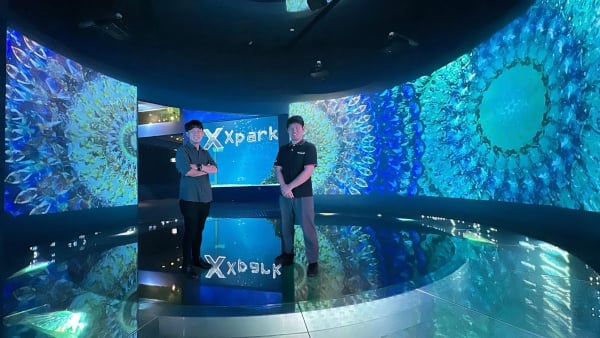
Terence Lee (left) with Dacoms engineer Brian Shih, who oversaw the Pandoras Box setup for the “Ocean of Light” exhibition.
Photo courtesy of Dacoms Technology
TL: As a Christie distributor for the past 25 years, we have great confidence in their products. The GS Series offers stable, moisture-resistant laser illumination, with an IP5X dust-resistant optical engine and solid-state illumination offering up to 20,000 hours that is ideal for aquarium conditions. The Captiva’s ultra-short-throw lens allows us to project a 3.8-meter-wide (12.5 foot) image from just one meter away, avoiding shadows cast by visitors. Pandoras Box allowed us to quickly integrate sensors, lighting, and music, and automate playback across the entire aquarium, reducing operational risks.
Q: Can you share insights into the process of integrating these technologies across 13 exhibition zones, and how you ensured consistency and reliability across such a large-scale deployment?
TL: We used built-in equipment color calibration and applied our team’s experience to make adjustments every six months. We also implemented dual-layer N+1 backups at both the display and control levels to ensure redundancy and automatic failover. Using a VPN and Christie AVI, we perform regular batch firmware updates and recalibrations to maintain long-term consistency.
The 2025 “Ocean of Light” Installation
Q: The new Ocean of Light: Immersive Ocean exhibition brings together digital art and real marine life in innovative ways. What were the unique technical and design challenges of this installation compared to the 2020 project?
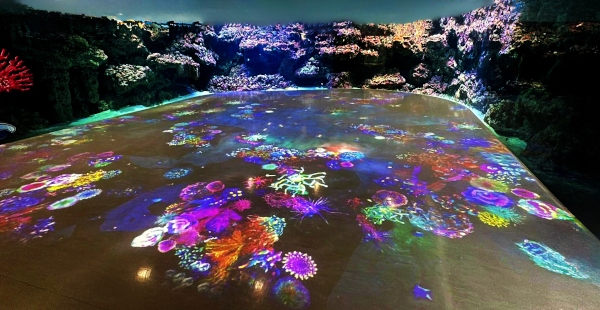
Colorful floor projections at the “Ocean of Light” exhibition that simulate an underwater ocean environment.
Photo courtesy of Dacoms Technology
TL: The biggest challenge was maintaining operations while adding seven new exhibition areas. In addition to technical hurdles, the project required meticulous planning and sequencing. I’m grateful to the NAKED INC. team for working closely with us on the content and overall effects. It was a true collaboration where we learned from each other. Now that this first Taiwan-Japan partnership has been a success, I believe a new exhibition will soon delight local audiences.
Q: What made Christie’s Inspire and GS Series projectors, and the Pandoras Box Servers, the right solution for this entertainment experience?
TL: The Inspire Series is one of Christie’s latest offerings, delivering excellent image quality and a range of model options. We’re also very familiar with the GS Series, which integrated seamlessly into the existing setup. Pandoras Box made system upgrades and expansions quick and smooth. Given the limited working hours, we’re glad to have chosen Christie for this major project, which allowed for seamless scalability.
Q: How did your team approach projection mapping onto expansive curved walls and floors while maintaining image fidelity and alignment?
TL: This expertise comes from years of hands-on experience and long-term development of our technical capabilities. We’re also thankful to Christie for continually improving their software, which helps ensure precise image alignment and quality.
Creative Collaboration and Impact
Q: Xpark’s latest exhibition is a collaboration with NAKED, INC. How did Dacoms work alongside NAKED to translate their creative vision into a seamless AV experience?
TL: We’re grateful to Xpark and NAKED Inc. for involving us from the early planning stages. This clarity allowed us to align on objectives from the start. I also want to thank our software team for their flexibility, which allowed NAKED to focus on their creative vision without hardware limitations. We then provided the technical solutions needed to realize that vision.
Q: In what ways do you think projection technology enhances storytelling and educational impact in venues like Xpark?
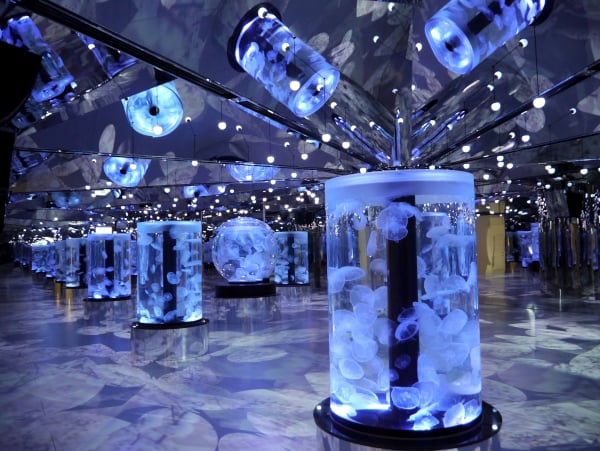
A key attraction at Xpark is the Healing Jellyfish zone, which blends technology and marine life with vivid projections.
Photo courtesy of Dacoms Technology
TL: From the beginning, our shared vision with Xpark was to animate the aquarium by blending virtual and real experiences. Both Dacoms and Xpark take the perspective of respecting marine life and advocating for sustainability. Our installations reflect this philosophy and help convey it to the public in meaningful ways.
Q: With the increasing popularity of LED display technology, do you think projection technology will be impacted in venues such as Xpark?
TL: LED display technology has its own unique advantages, making it well-suited for immersive presentations in specific scenarios. However, I don’t see it as being in direct conflict with projection technology. Each has its strengths, and the key is selecting the most appropriate solution for the space and purpose. The growing adoption of LED displays simply expands our creative toolkit, enabling more diverse, rich, and flexible immersive experiences.
Long-term Success and Learnings
Q: Looking back at both the 2020 and 2025 projects, what are you most proud of in Dacoms’ contributions to Xpark?
TL: Since opening in 2020, Xpark has welcomed over 10 million visitors. We were pioneers of immersive experiences in Taiwan, and since completing this project, we’ve delivered hundreds of similar installations. We’ve also seen other venues take inspiration from our work, which is an honor and a sign that audiences are eager for these experiences.
Q: What lessons from these projects would you share with other AV integrators tasked with similar large-scale, entertainment installations?
TL: Creativity and technology are the hardest things to replicate. I’m glad that more projects like this are happening in Taiwan, and it’s exciting to see new talent emerging. We’re always happy to collaborate with young artists to create even better immersive art.
Future Perspectives
Q: Do you see further opportunities to expand or evolve Xpark’s use of projection and image processing technology in the years ahead?
TL: Absolutely. We’re in ongoing discussions, and there are still many creative ideas yet to be realized. These not only challenge Xpark’s and the public’s expectations, but also push our technical capabilities. We believe technology’s purpose isn’t to show off—it’s to let audiences feel the rhythm of life through light and shadow. No matter how technology evolves, we’ll continue working with Xpark and creative partners to make the aquarium even more moving and inspiring.
Q: How do you see technologies like Christie’s shaping the future of immersive entertainment and attractions in Asia?
TL: Christie consistently delivers top-tier products and immersive visual experiences that are ideal for exhibitions and edutainment. Asia’s cultural richness and architectural diversity ranging from Taiwan’s fishing ports to Thai temples and Japanese commercial spaces make it a fertile stage for immersive storytelling. Projection adapts more easily than LED to curved surfaces, corridors, and historic facades, allowing artists to respect heritage while bringing in new narratives.
As we enter the era of ESG, public institutions need to rapidly digitize cultural resources. Governments are investing in the digital transformation of museum collections, archives, and ecological data. Artists can draw from this data to create generative visuals rooted in science and layered with poetic meaning. With shifting audience demographics, people are increasingly willing to pay for experiences. As long as the content resonates, it will find an audience, which in turn drives demand for better hardware and faster innovation.
